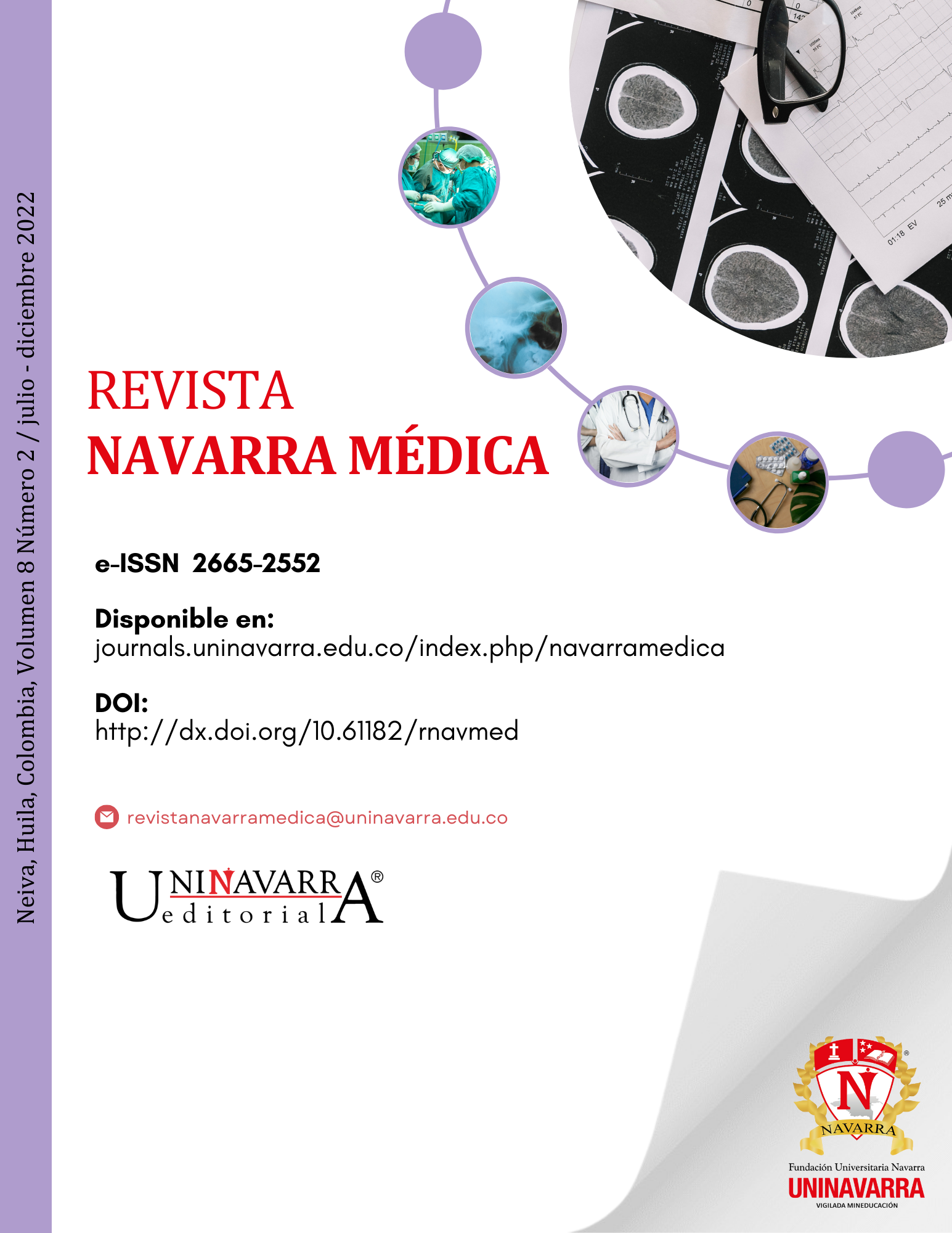Validation of trauma scales: experience at a trauma care enter in southern Colombia
DOI:
https://doi.org/10.61182/rnavmed.v8n2a3Keywords:
Glasgow coma scale, Revised Trauma Score, Shock IndexAbstract
Introduction: trauma is a public health problem that affects millions of people each year, generating a high rate of disability and mortality in young patients. Trauma scales are used to predict the prognosis of multiple trauma patients on admission to the emergency room. The use of these tools forces health personnel to be skilled in their interpretation, and thus direct management. The objective of the research is to validate the different trauma scales in patients managed in a hospital in Colombia.
Methodology: descriptive, observational, cross-sectional study of multiple trauma patients who were admitted to a trauma center between January and December 2019. The shock index (SI) was determined as a prognostic variable that generated two groups: group A (SI less than 0.9) and group B (IS greater than 0.9), in relation to this, the clinical findings were evaluated and the Injury Severity Index (ISS), Revised Trauma Score (RTS) and the Glasgow Coma Scale were evaluated.
Results: 180 patients were analyzed, 56.6 % presented SI less than 0.9 and 43.3 % greater than 0.9. The ISS for group A yielded a mean of 13.7, however, the patients who died in that group had an ISS greater than 24. The mean RTS was 7.2. The mean GCS was 11.7 and those patients who died had GCS less than 9. The overall mortality in group A was 16.6 %. For group B, mortality was 80.7 %, the behavior of the ISS was greater than 30.9, the RTS presented a mean of 6.3 and the average of the GCS was 8.2.
Conclusion: it was determined that the Shock Index allows predicting an unfavorable prognosis in trauma patients, which is correlated and validated when applying the ISS and GCS in the emergency room.
References
1. United Nations, Deparment of Economic and Social Affair, Population Division. World Mortality 2019: Highlights.pdf [Internet]. New York: United Nations; 2019 [citado 1 de octubre de 2020].Disponible en: https://www.un.org/en/development/desa/population/publications/pdf/mortality/WMR2019/WMR2019_Highlights.pdf
2. World Health Organization. Global status report on road safety 2018 [Internet]. Geneva: WHO [citado 1 de octubre de 2020]. Disponible en: https://www.who.int/publications-detail-redirect/global-status-report-on-road-safety-2018
3. Ramachandran A, Ranjit A, Zogg CK, Herrera-Escobar JP, Appelson JR, Pino LF, et al. Comparison of epidemiology of the injuries and outcomes in two first-level trauma centers in colombia using the pan-american trauma registry system. World J Surg. 2017;41(9):2224-30. doi:10.1007/s00268-017-4013-8
4. Fraade-Blanar L, Concha-Eastman A, Baker T. Injury in the Americas: the relative burden and challenge. Rev Panam Salud Publica. 2007;22(4):254-9. doi:10.1590/s1020-49892007000900005
5. Ordóñez CA, Botache WF, Pino LF, Badiel M, Tejada JW, Sanjuán J, et al. Experiencia en dos hospitales de tercer nivel de atención del suroccidente de Colombia en la aplicación del Registro Internacional de Trauma de la Sociedad Panamericana de Trauma. Rev Colomb Cir. 2013;28(1):39-47. doi:10.30944/20117582.245
6. United Nations, Deparment of Economic and Social Affairs, Population Division. World Mortality 2019: Highlights [Internet]. New York: United Nations; 2020. Available from: https://www.un.org/en/development/desa/population/publications/pdf/mortality/WMR2019/WMR2019_Highlights.pdf
7. Ordoñez CA, Morales M, Rojas-Mirquez JC, Bonilla-Escobar FJ, Badiel M, Miñán Arana F, et al. Trauma registry of the Pan-American trauma society: one year of experience in two hospitals in southwest Colombia. Colomb Med (Cali). 2016; 47(3):148-54.
8. Instituto Nacional de Medicina Legal y Ciencias Forenses. Forensis [Internet]. Bogotá: Instituto Nacional de Medicina Legal y Ciencias Forenses; [citado 1 de octubre de 2020]. Disponible en: https://www.medicinalegal.gov.co/cifras-estadisticas/forensis
9. Gonzalez E, Moore EE, Moore HB. Management of Trauma Induced Coagulopathy with Thrombelastography. Crit Care Clin. 2017;33(1):119-34. doi:10.1016/j.ccc.2016.09.002
10. Tisherman SA, Schmicker RH, Brasel KJ, Bulger EM, Kerby JD, Minei JP, et al. Detailed description of all deaths in both the shock and traumatic brain injury hypertonic saline trials of the Resuscitation Outcomes Consortium. Ann Surg. 2015;261(3):586-90. doi:10.1097/SLA.0000000000000837
11. Ali Ali B, Fortún Moral M, Belzunegui Otano T, Reyero Díez D, Castro Neira M. Escalas para predicción de resultados tras traumatismo grave [Scales for predicting outcome after severe trauma]. An Sist Sanit Navar. 2017;40(1):103-18. doi:10.23938/ASSN.001
12. Champion HR. Trauma Scoring. Scand J Surg. 2002;91(1):12-22. doi:10.1177/145749690209100104
13. Restrepo-Álvarez CA, Valderrama-Molina CO, Giraldo-Ramírez N, Constain-Franco A, Puerta A, León AL, et al. Puntajes de gravedad en trauma. Revista Colombiana de Anestesiología. 2016;44(4):317-23. https://www.revcolanest.com.co/index.php/rca/article/view/609
14. Charry JD, Bermeo JM, Montoya KF, Calle-Toro JS, Núñez LR, Poveda G. Índice de shock como factor predictor de mortalidad en el paciente con trauma penetrante de tórax. Rev Colomb Cir. 2015;30(1):24-8. doi:10.30944/20117582.307
15. Departamento Administrativo de Ciencia, Tecnología e Innovación (Minciencias). Política de ética, bioética e integridad científica [Internet]. Bogotá: Minciencias; 2018 Feb. Disponible en: https://minciencias.gov.co/sites/default/files/upload/noticias/politica-etica.pdf
16. Kilgo PD, Meredith JW, Hensberry R, Osler TM. A note on the disjointed nature of the injury severity score. J Trauma. 2004;57(3):479-85; discussion 486-487. doi:10.1097/01.ta.0000141024.96440.7c
17. Rozenfeld M, Radomislensky I, Freedman L, Givon A, Novikov I, Peleg K. ISS groups: are we speaking the same language? Inj Prev. 2014;20(5):330-5. doi: 10.1136/injuryprev-2013-041042
18. Serviá L, Badia M, Montserrat N, Trujillano J. Gravedad en pacientes traumáticos ingresados en UCI. Modelos fisiológicos y anatómicos. Med Intensiva. 2019;43(1):26-34. doi:10.1016/j.medin.2017.11.008
19. Rowell SE, Barbosa RR, Diggs BS, Schreiber MA, Trauma Outcomes Group, Holcomb JB, et al. Specific abbreviated injury scale values are responsible for the underestimation of mortality in penetrating trauma patients by the injury severity score. J Trauma. 2011;71(2 Suppl 3):S384-8. doi:10.1097/TA.0b013e3182287c8d
20. Galvagno SM Jr, Massey M, Bouzat P, Vesselinov R, Levy MJ, Millin MG, et al. Correlation between the revised trauma score and injury severity score: implications for prehospital trauma triage. Prehosp Emerg Care. 2019;23(2):263-70. doi:10.1080/10903127.2018.1489019
21. Huang YT, Huang YH, Hsieh CH, Li CJ, Chiu IM. Comparison of injury severity score, Glasgow Coma Scale, and revised trauma score in predicting the mortality and prolonged ICU stay of traumatic young children: a cross-sectional retrospective study. Emerg Med Int. 2019;2019:5453624. doi: 10.1155/2019/5453624
22. Yousefzadeh-Chabok S, Hosseinpour M, Kouchakinejad-Eramsadati L, Ranjbar F, Malekpouri R, Razzaghi A, et al. Comparison of Revised Trauma Score, Injury Severity Score and Trauma and Injury Severity Score for mortality prediction in elderly trauma patients. Ulus Travma Acil Cerrahi Derg. 2016;22(6):536-40. doi: 10.5505/tjtes.2016.93288
23. McNab A, Burns B, Bhullar I, Chesire D, Kerwin A. A prehospital shock index for trauma correlates with measures of hospital resource use and mortality. Surgery. 2012;152(3):473-6. doi: 10.1016/j.surg.2012.07.010
Downloads
Published
Issue
Section
License
Copyright (c) 2025 Sergio A. Cristancho-Losada , Sammy Felipe Castellanos-Rojas, Jose D. Charry

This work is licensed under a Creative Commons Attribution-NonCommercial 4.0 International License.








